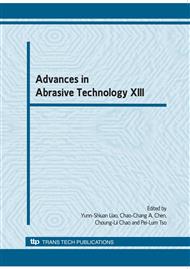p.165
p.171
p.177
p.181
p.189
p.195
p.202
p.208
p.214
Laboratory Comparison of Mini-Discs with Point-Attack Picks
Abstract:
The selection of the cutter type is of crucial importance to maximise the advantages of mechanical rock excavation systems. Specific energy (SE), cutter forces, and rock properties are used to decide what type of cutter is most suitable for economical excavation of the rock based on laboratory rock cutting tests. This study is concerned with the preliminary results of an ongoing rock cutting program in which a mini-disc has been compared with a point-attack pick in laboratory linear cutting tests simulating a cutterhead on a Helidon sandstone block. Analysis of the preliminary results has shown that the mini-disc experienced lower mean cutting forces and was seven times more efficient than the pick in first layer cuts. However, the mini-disc had mean normal forces 1.5 times higher than the pick. Additionally, first layer cuts taken on the trimmed surfaces required more forces and SE than completely relieved cuts in pick cutting.
Info:
Periodical:
Pages:
189-194
Citation:
Online since:
August 2010
Authors:
Price:
Сopyright:
© 2010 Trans Tech Publications Ltd. All Rights Reserved
Share:
Citation:


